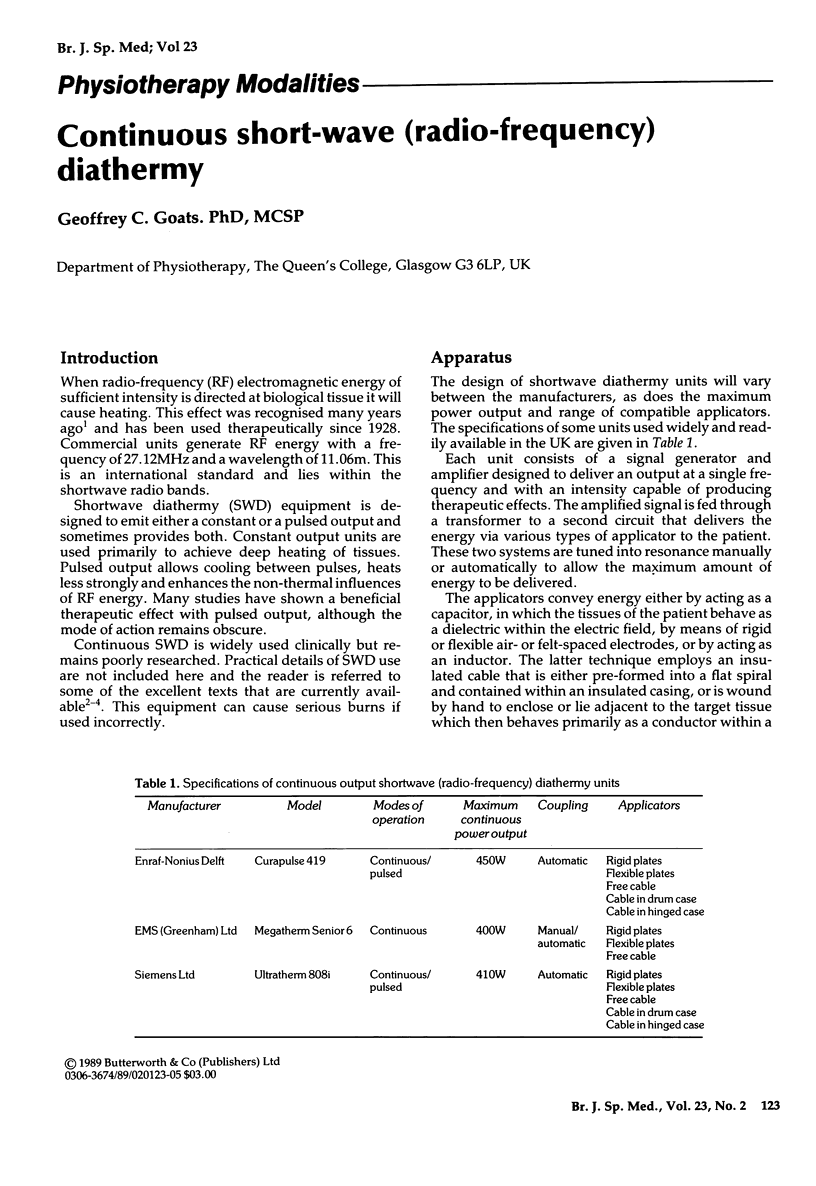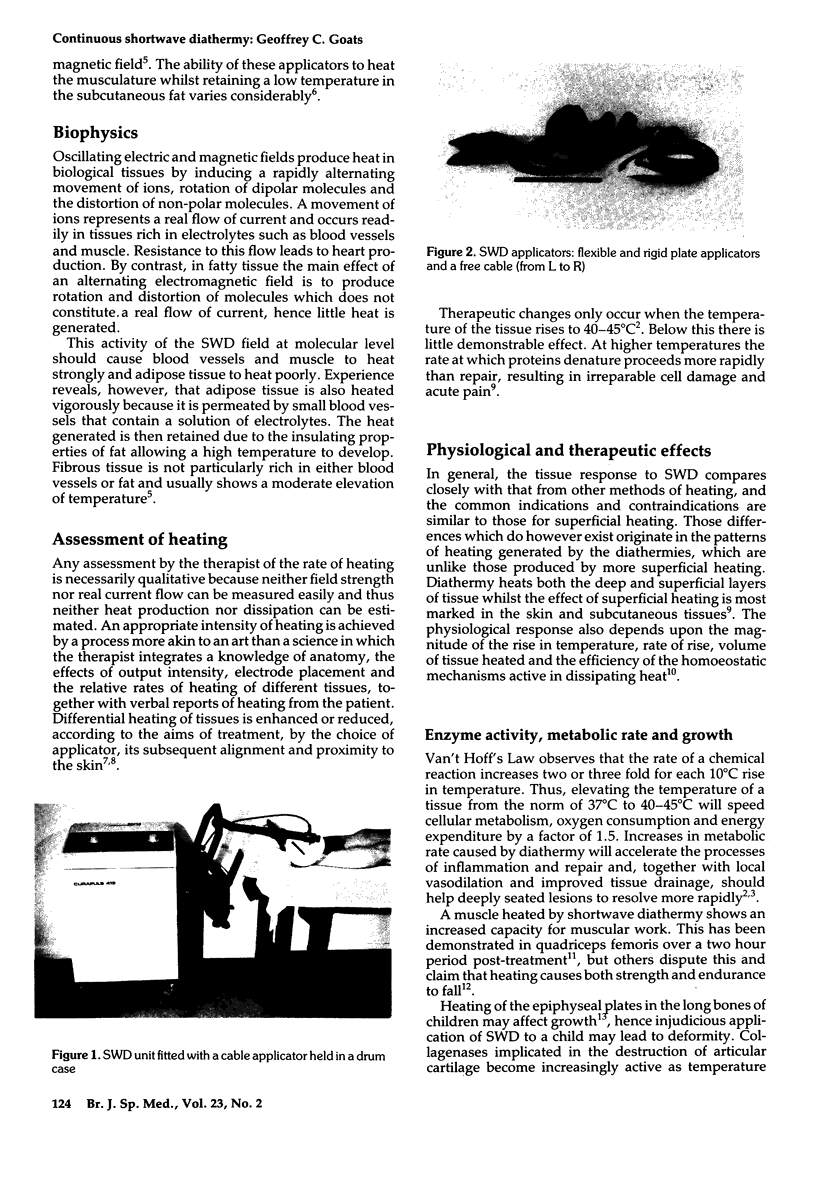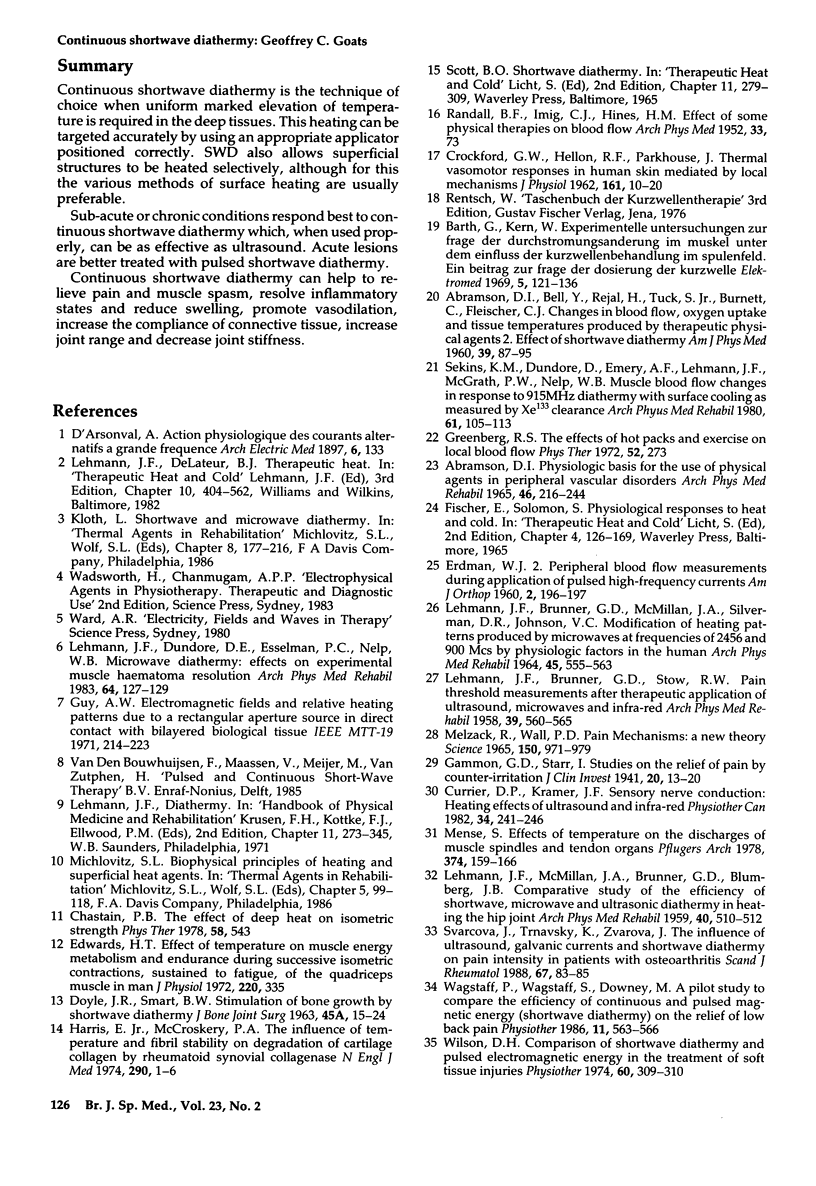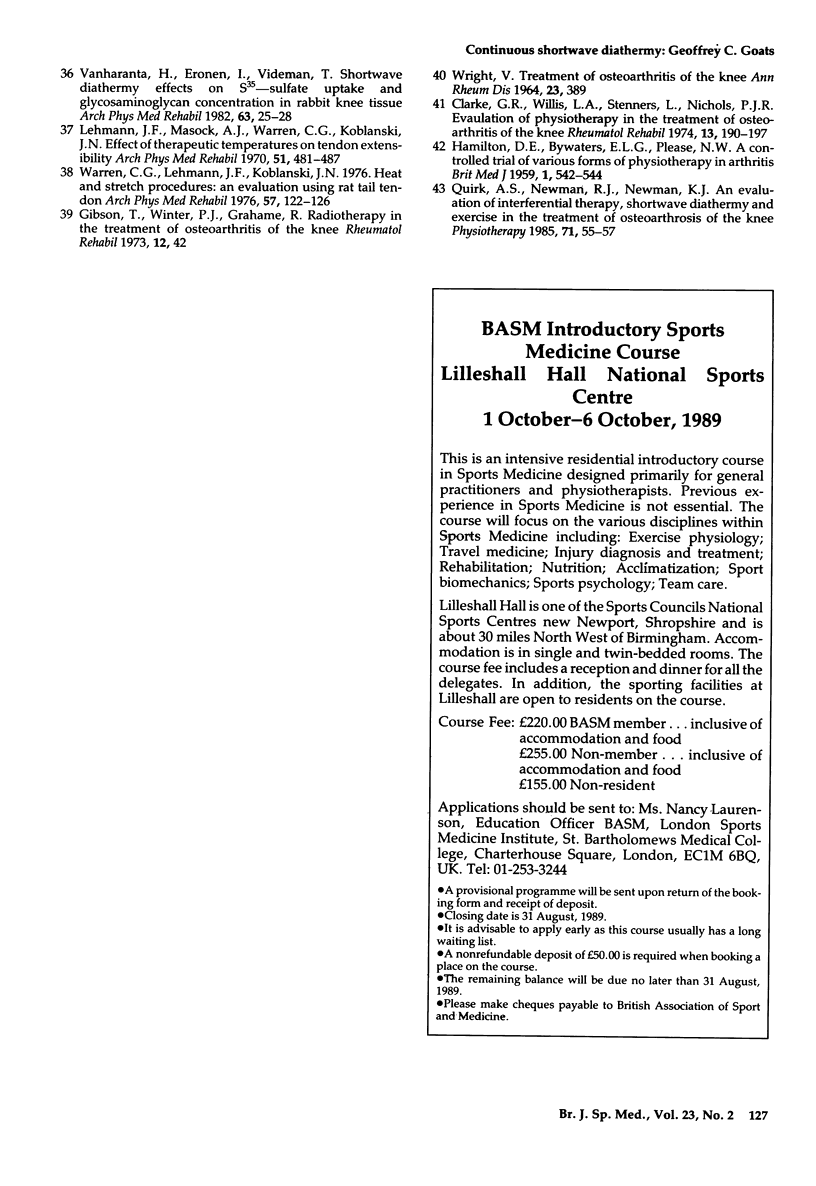Abstract
Continuous shortwave diathermy is the technique of choice when uniform marked elevation of temperature is required in the deep tissues. This heating can be targeted accurately by using an appropriate applicator positioned correctly. SWD also allows superficial structures to be heated selectively, although for this the various methods of surface heating are usually preferable. Sub-acute or chronic conditions respond best to continuous shortwave diathermy which, when used properly, can be as effective as ultrasound. Acute lesions are better treated with pulsed shortwave diathermy. Continuous shortwave diathermy can help to relieve pain and muscle spasm, resolve inflammatory states and reduce swelling, promote vasodilation, increase the compliance of connective tissue, increase joint range and decrease joint stiffness.
Full text
PDF




Images in this article
Selected References
These references are in PubMed. This may not be the complete list of references from this article.
- ABRAMSON D. I., BELL Y., REJAL H., TUCK S., Jr, BURNETT C., FLEISCHER C. J. Changes in blood flow, oxygen uptake and tissue temperatures produced by therapeutic physical agents. II. Effect of short-wave diathermy. Am J Phys Med. 1960 Jun;39:87–95. [PubMed] [Google Scholar]
- ABRAMSON D. I. PHYSIOLOGIC BASIS FOR THE USE OF PHYSICAL AGENTS IN PERIPHERAL VASCULAR DISORDERS. Arch Phys Med Rehabil. 1965 Mar;46:216–244. [PubMed] [Google Scholar]
- CROCKFORD G. W., HELLON R. F., PARKHOUSE J. Thermal vasomotor responses in human skin mediated by local mechanisms. J Physiol. 1962 Apr;161:10–20. doi: 10.1113/jphysiol.1962.sp006869. [DOI] [PMC free article] [PubMed] [Google Scholar]
- Chastain P. B. The effect of deep heat on isometric strength. Phys Ther. 1978 May;58(5):543–546. doi: 10.1093/ptj/58.5.543. [DOI] [PubMed] [Google Scholar]
- Clarke G. R., Willis L. A., Stenners L., Nichols P. J. Evaluation of physiotherapy in the treatment of osteoarthrosis of the knee. Rheumatol Rehabil. 1974 Nov;13(4):190–197. doi: 10.1093/rheumatology/13.4.190. [DOI] [PubMed] [Google Scholar]
- Edwards R. H., Harris R. C., Hultman E., Kaijser L., Koh D., Nordesjö L. O. Effect of temperature on muscle energy metabolism and endurance during successive isometric contractions, sustained to fatigue, of the quadriceps muscle in man. J Physiol. 1972 Jan;220(2):335–352. doi: 10.1113/jphysiol.1972.sp009710. [DOI] [PMC free article] [PubMed] [Google Scholar]
- Gammon G. D., Starr I. STUDIES ON THE RELIEF OF PAIN BY COUNTERIRRITATION. J Clin Invest. 1941 Jan;20(1):13–20. doi: 10.1172/JCI101190. [DOI] [PMC free article] [PubMed] [Google Scholar]
- Greenberg R. S. The effects of hot packs and exercise on local blood flow. Phys Ther. 1972 Mar;52(3):273–278. doi: 10.1093/ptj/52.3.273. [DOI] [PubMed] [Google Scholar]
- HAMILTON D. E., BYWATERS E. G., PLEASE N. W. A controlled trial of various forms of physiotherapy in arthritis. Br Med J. 1959 Feb 28;1(5121):542–544. doi: 10.1136/bmj.1.5121.542. [DOI] [PMC free article] [PubMed] [Google Scholar]
- LEHMANN J. F., BRUNNER G. D., MCMILLAN J. A., SILVERMAN D. R., JOHNSTON V. C. MODIFICATION OF HEATING PATTERNS PRODUCED BY MICROWAVES AT THE FREQUENCIES OF 2456 AND 900 MC. BY PHYSIOLOGIC FACTORS IN THE HUMAN. Arch Phys Med Rehabil. 1964 Nov;45:555–563. [PubMed] [Google Scholar]
- LEHMANN J. F., BRUNNER G. D., STOW R. W. Pain threshold measurements after therapeutic application of ultrasound, microwaves and infrared. Arch Phys Med Rehabil. 1958 Sep;39(9):560–565. [PubMed] [Google Scholar]
- LEHMANN J. F., MCMILLAN J. A., BRUNNER G. D., BLUMBERG J. B. Comparative study of the efficiency of short-wave, microwave and ultrasonic diathermy in heating the hip joint. Arch Phys Med Rehabil. 1959 Dec;40:510–512. [PubMed] [Google Scholar]
- Lehmann J. F., Dundore D. E., Esselman P. C., Nelp W. B. Microwave diathermy: effects on experimental muscle hematoma resolution. Arch Phys Med Rehabil. 1983 Mar;64(3):127–129. [PubMed] [Google Scholar]
- Lehmann J. F., Masock A. J., Warren C. G., Koblanski J. N. Effect of therapeutic temperatures on tendon extensibility. Arch Phys Med Rehabil. 1970 Aug;51(8):481–487. [PubMed] [Google Scholar]
- Melzack R., Wall P. D. Pain mechanisms: a new theory. Science. 1965 Nov 19;150(3699):971–979. doi: 10.1126/science.150.3699.971. [DOI] [PubMed] [Google Scholar]
- Mense S. Effects of temperature on the discharges of muscle spindles and tendon organs. Pflugers Arch. 1978 May 18;374(2):159–166. doi: 10.1007/BF00581297. [DOI] [PubMed] [Google Scholar]
- Sekins K. M., Dundore D., Emery A. F., Lehmann J. F., McGrath P. W., Nelp W. B. Muscle blood flow changes in response to 915 MHz diathermy with surface cooling as measured by Xe133 clearance. Arch Phys Med Rehabil. 1980 Mar;61(3):105–113. [PubMed] [Google Scholar]
- Svarcová J., Trnavský K., Zvárová J. The influence of ultrasound, galvanic currents and shortwave diathermy on pain intensity in patients with osteoarthritis. Scand J Rheumatol Suppl. 1987;67:83–85. doi: 10.3109/03009748809105306. [DOI] [PubMed] [Google Scholar]
- Vanharanta H., Eronen I., Videman T. Shortwave diathermy effects on 35S-sulfate uptake and glycosaminoglycan concentration in rabbit knee tissue. Arch Phys Med Rehabil. 1982 Jan;63(1):25–28. [PubMed] [Google Scholar]
- WRIGHT V. TREATMENT OF OSTEO-ARTHRITIS OF THE KNEES. Ann Rheum Dis. 1964 Sep;23:389–391. doi: 10.1136/ard.23.5.389. [DOI] [PMC free article] [PubMed] [Google Scholar]
- Warren C. G., Lehmann J. F., Koblanski J. N. Heat and stretch procedures: an evaluation using rat tail tendon. Arch Phys Med Rehabil. 1976 Mar;57(3):122–126. [PubMed] [Google Scholar]
- Wilson D. H. Comparison of short wave diathermy and pulsed electromagnetic energy in treatment of soft tissue injuries. Physiotherapy. 1974 Oct;60(10):309–310. [PubMed] [Google Scholar]




